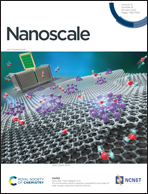Metal ion endogenous cycles of CoFe2O4−x induced boosted photocatalytic/PMS degradation toward polycyclic aromatic hydrocarbons†
Abstract
The rational design of photocatalytic nanomaterials with unique structures is critical for remediating environmental problems and thus reducing ecological risks. In this work, we employed H2 temperature-programmed reduction to modify MFe2O4 (M = Co, Cu, and Zn) photocatalysts for obtaining additional oxygen vacancies. After activation of PMS, naphthalene and phenanthrene degradation rates in the soil phase were increased by 3.24-fold and 1.39-fold, respectively, and 1.38-fold for naphthalene in the aqueous phase by H-CoFe2O4−x. The extraordinary photocatalytic activity is attributed to the oxygen vacancies on the H-CoFe2O4−x surface, which promote electron transfer and thus enhance the redox cycle from Co(III)/Fe(III) to Co(II)/Fe(II). In addition, oxygen vacancies are used as electron traps to hinder the recombination of photogenerated carriers and accelerate the generation of hydroxyl and superoxide radicals. Quenching tests showed that the addition of p-benzoquinone resulted in the greatest decrease in the degradation rate of naphthalene (inhibition of about 85.5%), demonstrating that O2˙− radicals are the main active species in the photocatalytic degradation of naphthalene. H-CoFe2O4−x showed improved degradation performance in synergy with PMS (82.0%, kapp = 0.00714 min−1) while maintaining excellent stability and reusability. Hence, this work provides a promising approach for the design of efficient photocatalysts to degrade persistent organic pollutants in soil and aqueous environments.

- This article is part of the themed collection: Celebrating 25 years of the Key Laboratory for Special Functional Materials at Henan University


 Please wait while we load your content...
Please wait while we load your content...